Quintic B-Spline collocation method for numerical solution a modified GRLW equations
In this paper, numerical solution of a modified generalized regularized long
wave (mGRLW) equation are obtained by a method based on collocation of quintic B –
splines. Applying the von – Neumann stability analysis, the proposed method is shown to
be unconditionally stable. The numerical result shows that the present method is a
successful numerical technique for solving the GRLW and mRGLW equations that they
have real exact solutions.
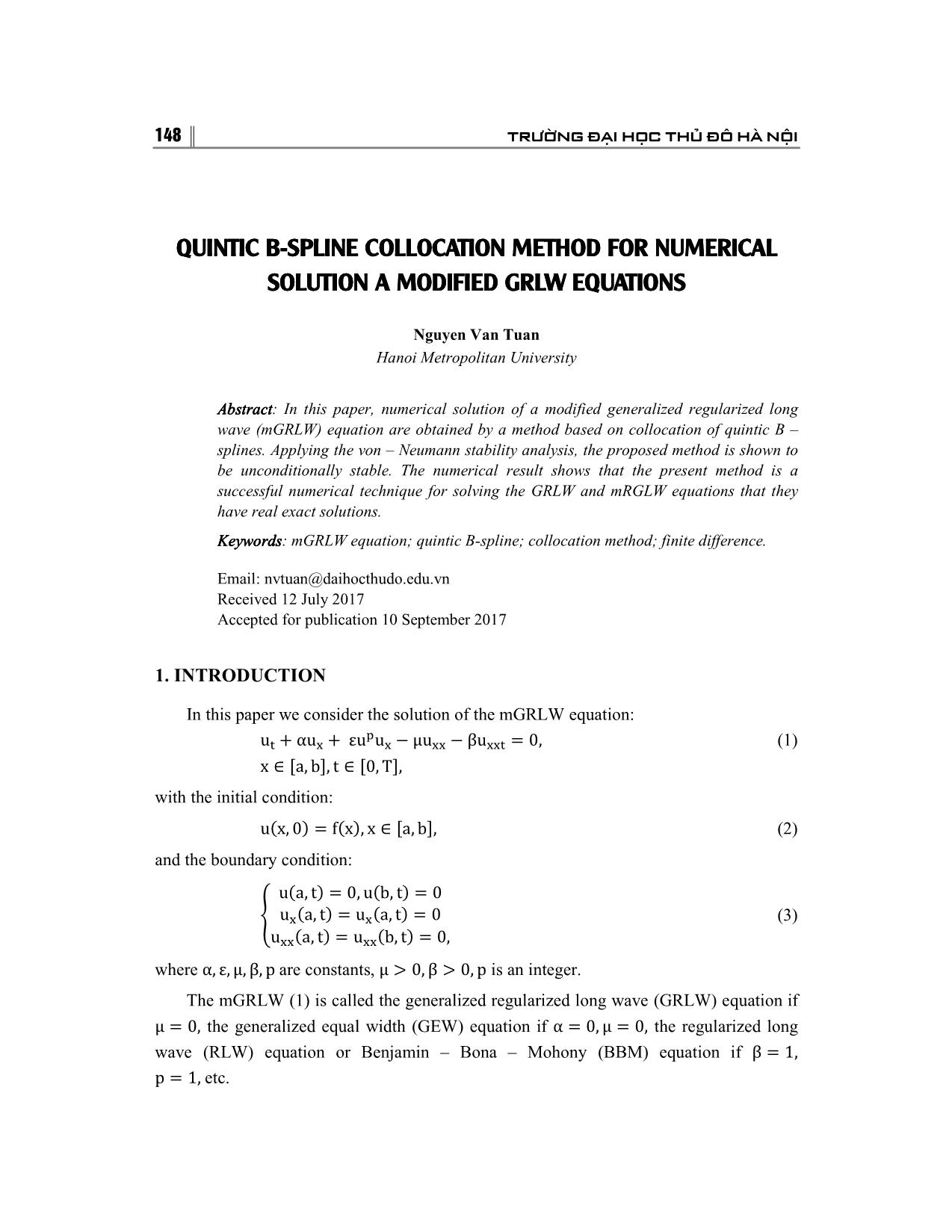
Trang 1
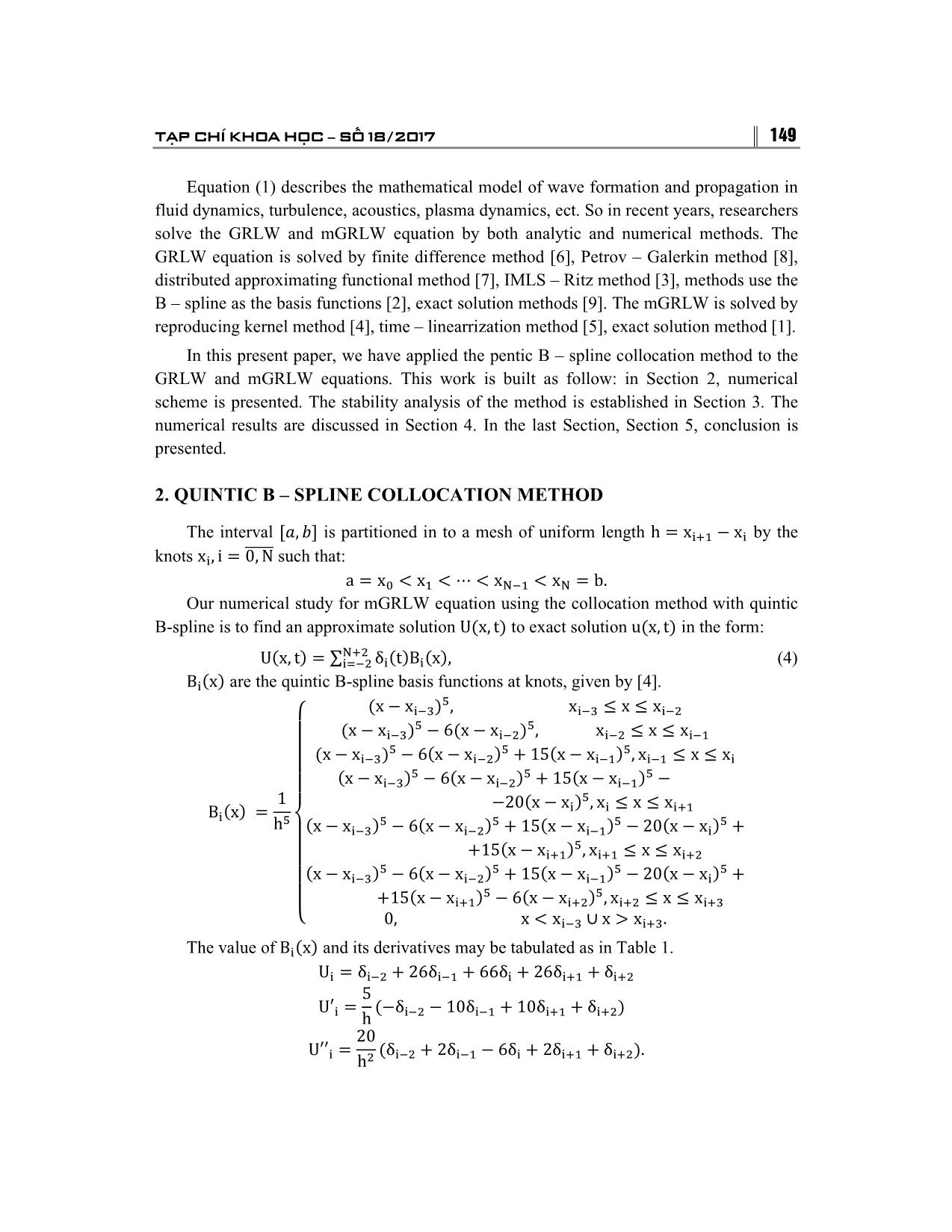
Trang 2
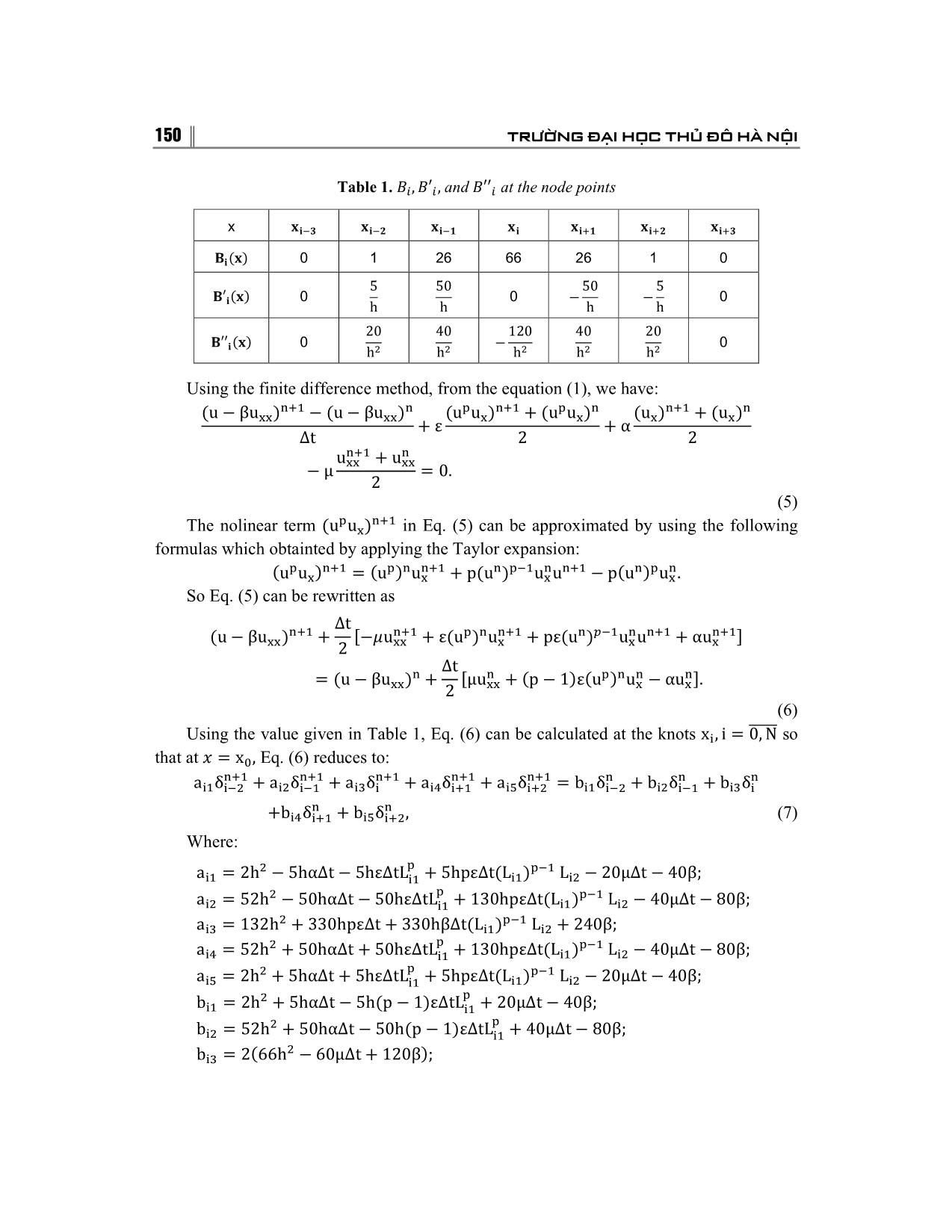
Trang 3
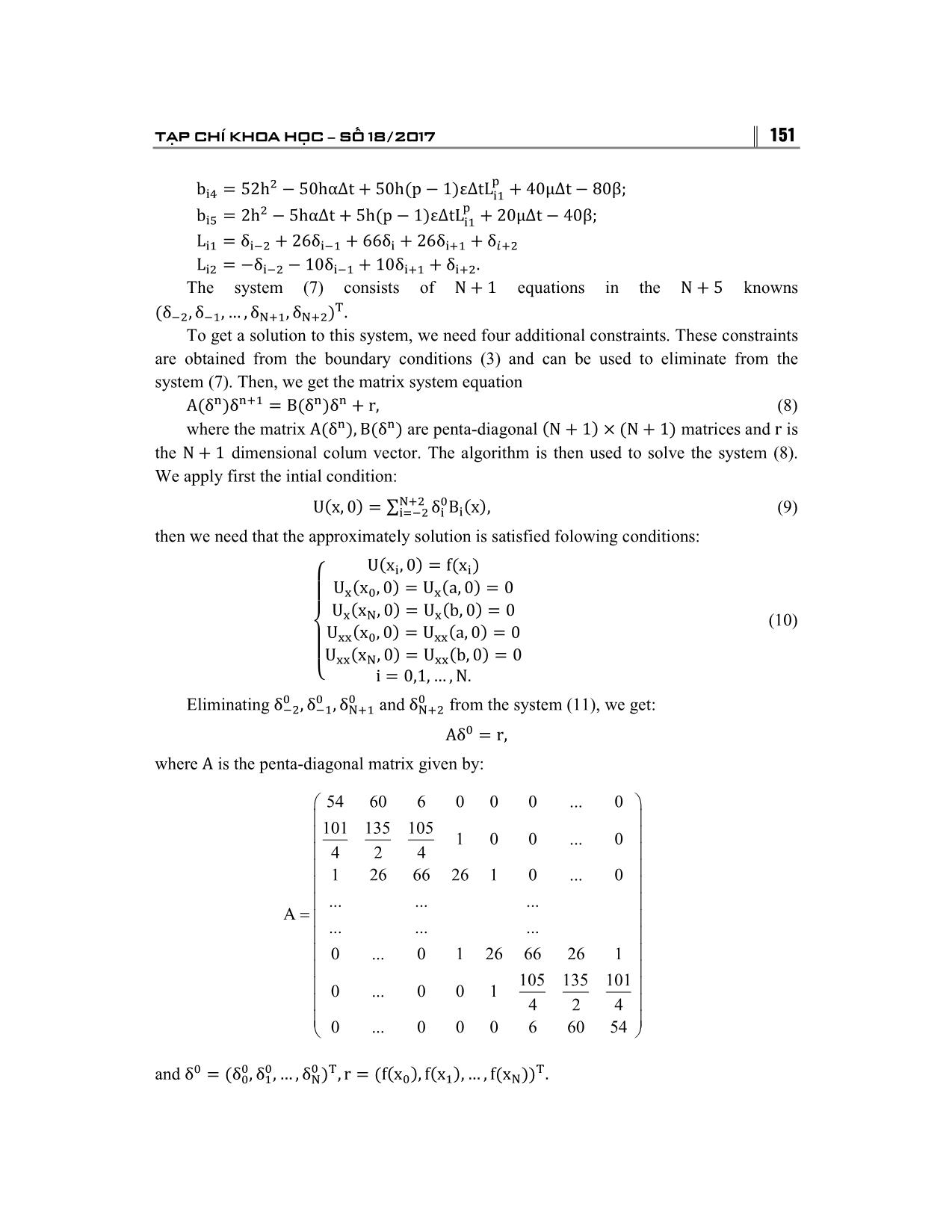
Trang 4
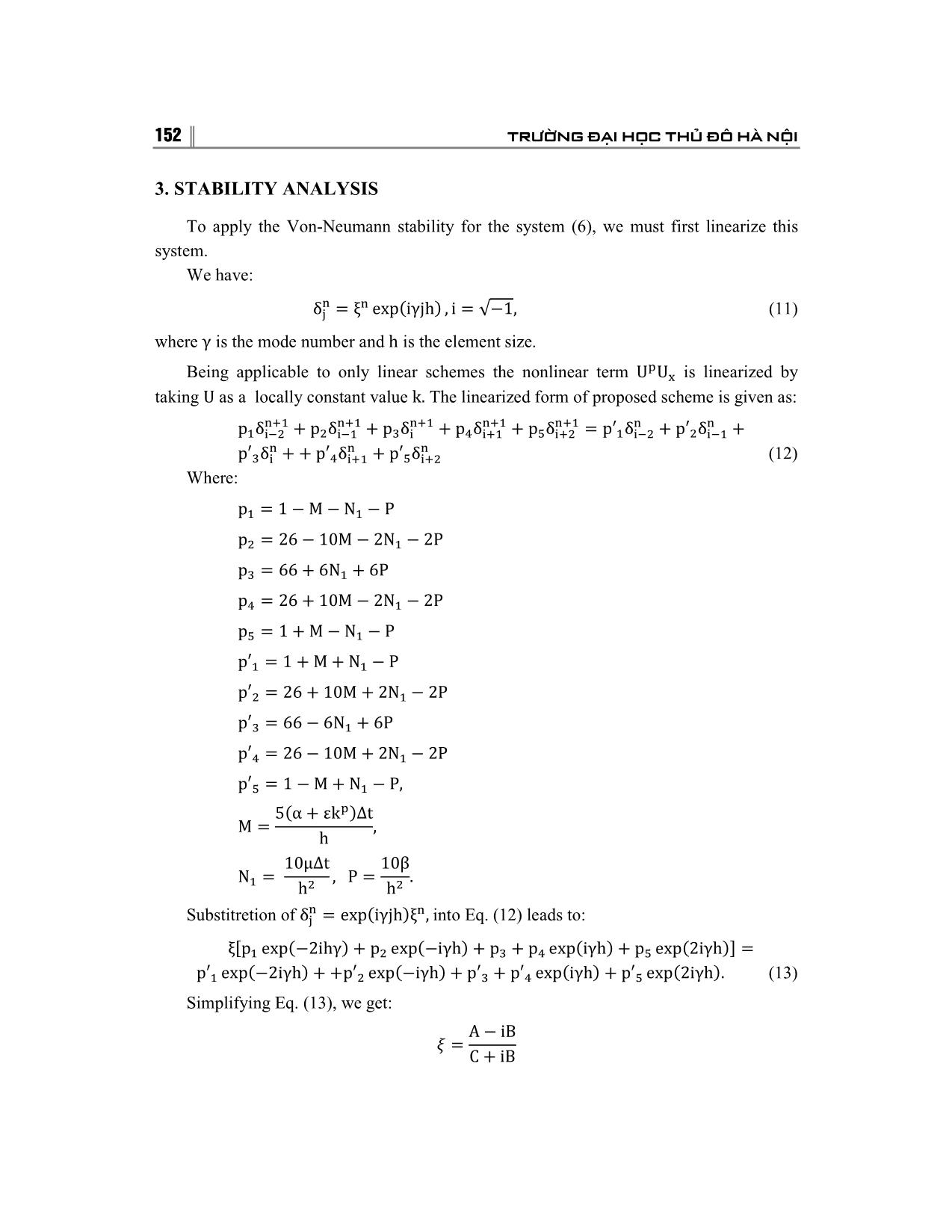
Trang 5
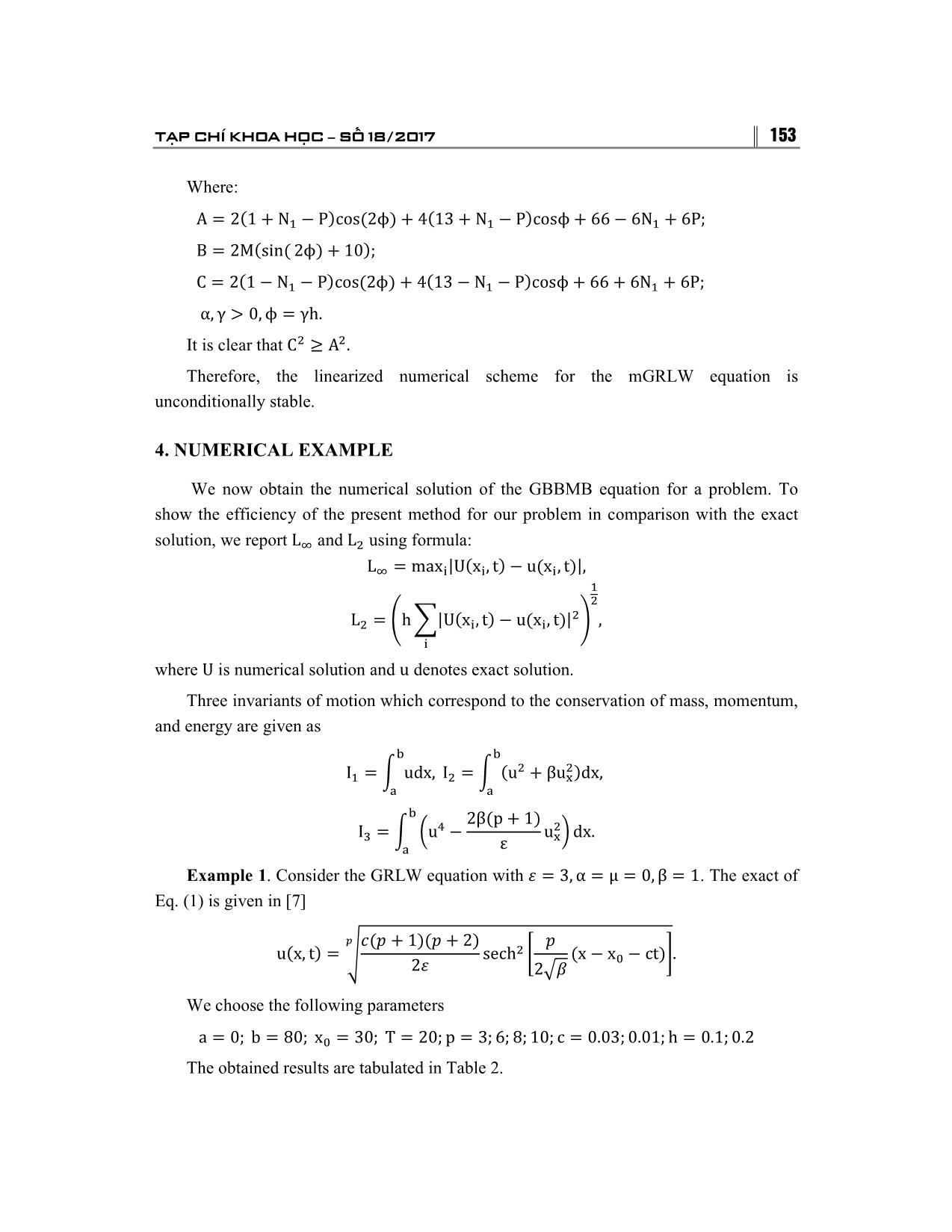
Trang 6
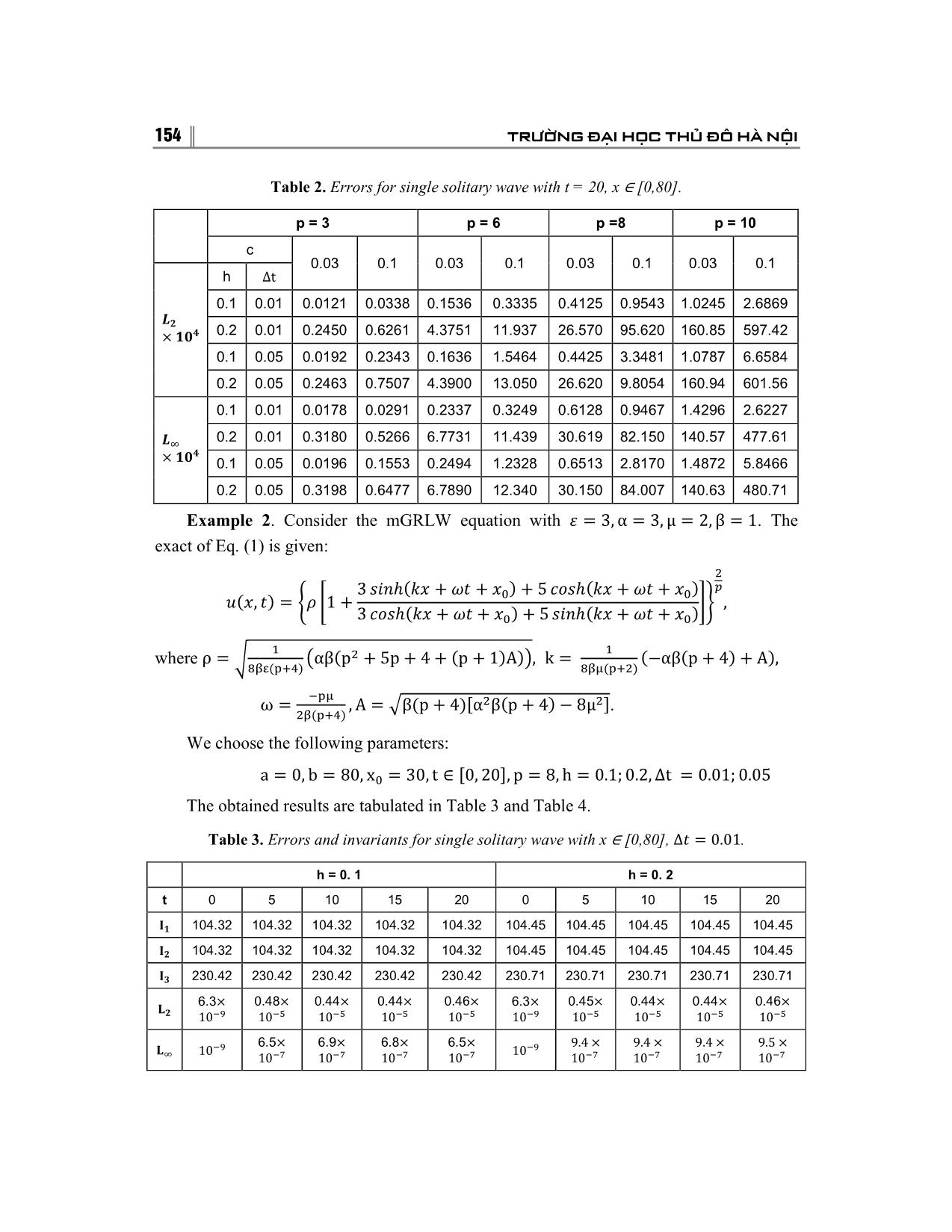
Trang 7
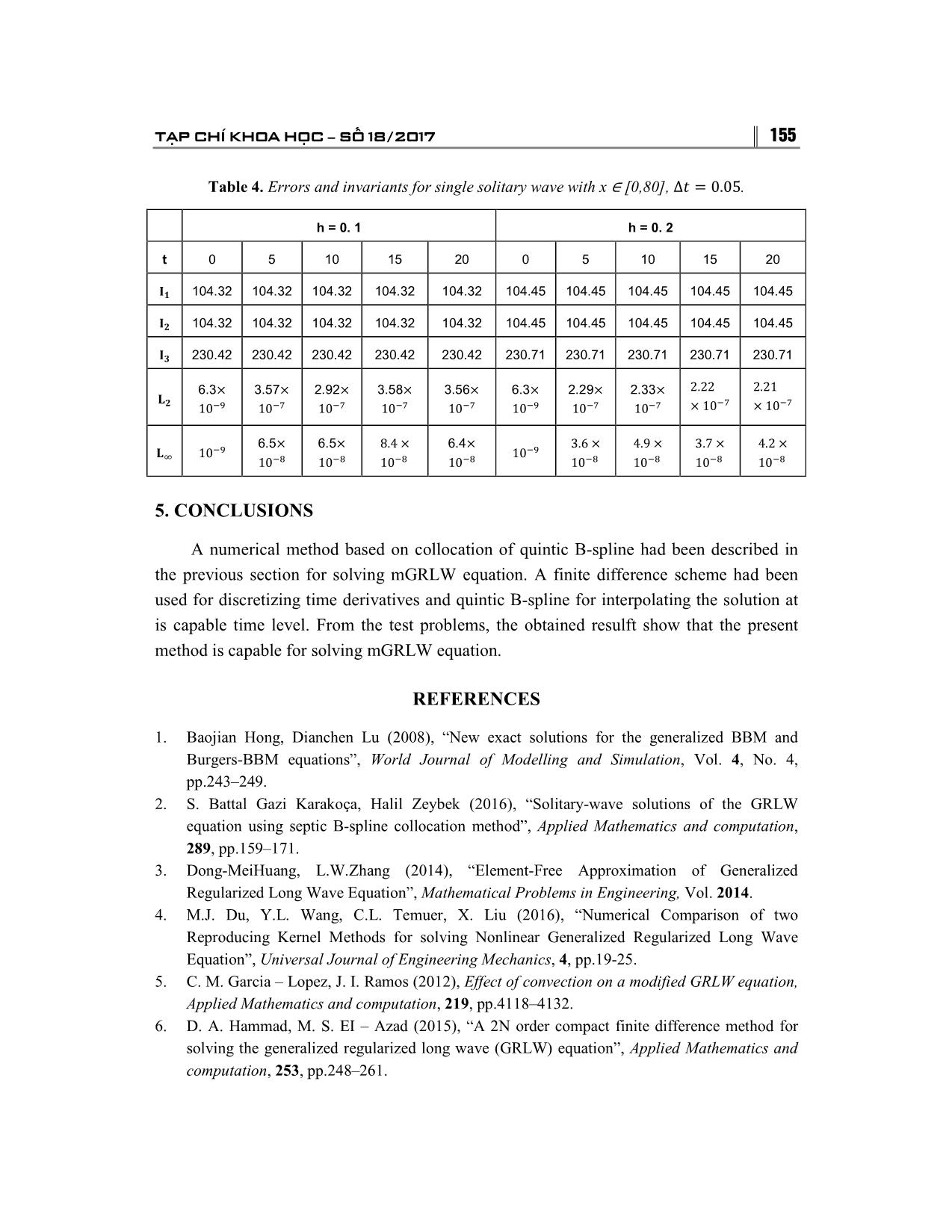
Trang 8
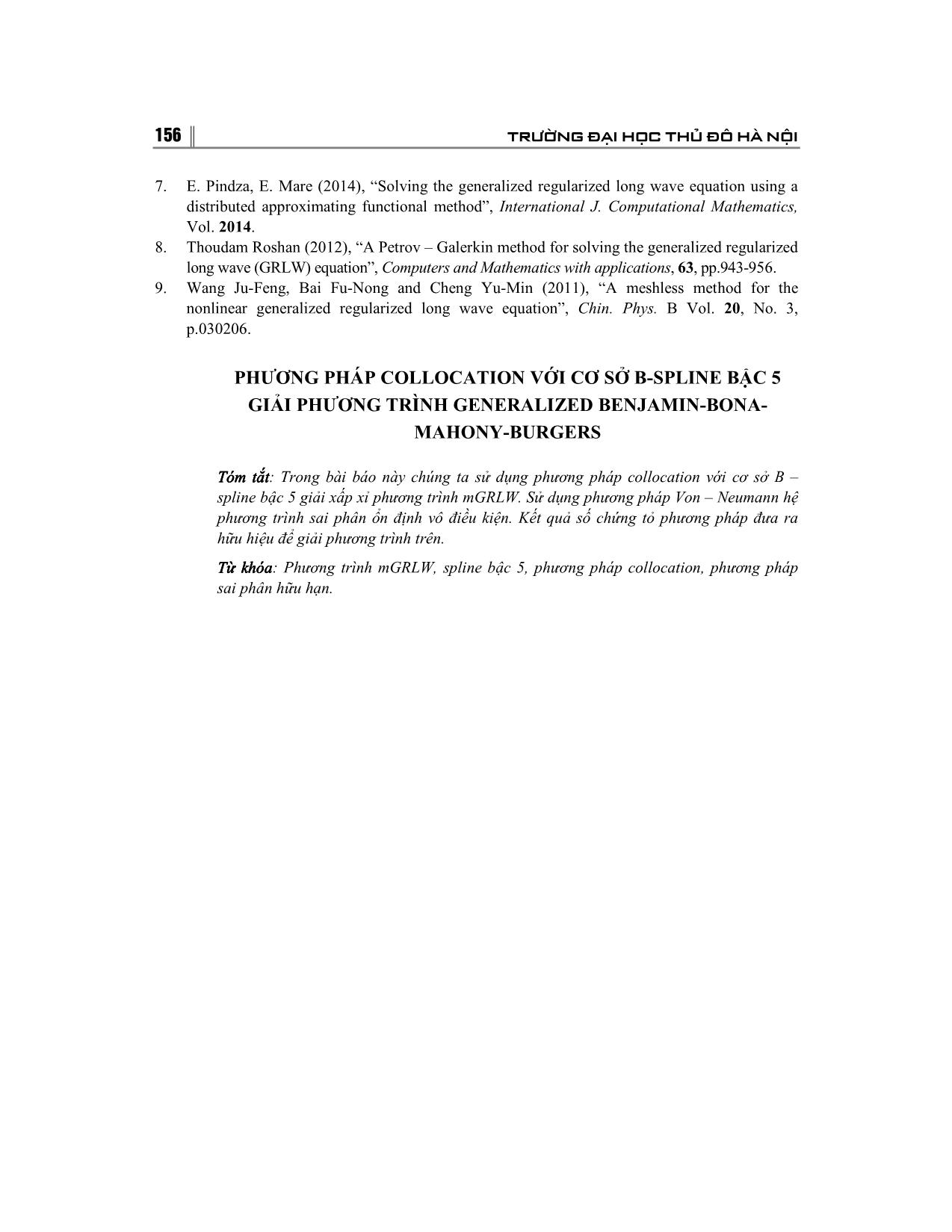
Trang 9
Bạn đang xem tài liệu "Quintic B-Spline collocation method for numerical solution a modified GRLW equations", để tải tài liệu gốc về máy hãy click vào nút Download ở trên
Tóm tắt nội dung tài liệu: Quintic B-Spline collocation method for numerical solution a modified GRLW equations
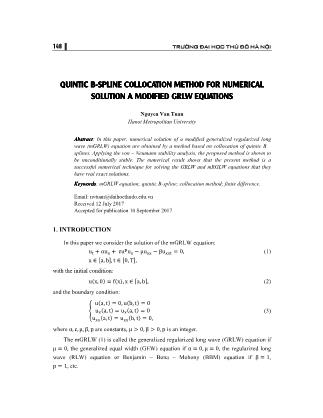
��SPLINESPLINE COLLOCATION METHOD FOR NUMERICAL SOLUTION A MODIMODIFIEDFIED GRLW EQUATIONS Nguyen Van Tuan Hanoi Metropolitan University AbstractAbstract: In this paper, numerical solution of a modified generalized regularized long wave (mGRLW) equation are obtained by a method based on collocation of quintic B – splines. Applying the von – Neumann stability analysis, the proposed method is shown to be unconditionally stable. The numerical result shows that the present method is a successful numerical technique for solving the GRLW and mRGLW equations that they have real exact solutions. KeywordsKeywords: mGRLW equation; quintic B�spline; collocation method; finite difference. Email: nvtuan@daihocthudo.edu.vn Received 12 July 2017 Accepted for publication 10 September 2017 1. INTRODUCTION In this paper we consider the solution of the mGRLW equation: (1) � u� � αu� � εu u� � μu�� � βu��� � 0, with the initial xcondition: ∈ �a, b�, t ∈ �0, T�, (2) and the boundaryu� x,condition: 0� � f�x �, x ∈ �a, b�, u�a, t� � 0, u�b, t� � 0 (3) � u��a, t� � u��a, t� � 0 u�� �a, t� � u�� �b, t� � 0, where are constants, is an integer. Theα, ε,mGRLW μ, β, p (1) is called theμ � generalized 0, β � 0, p regularized long wave (GRLW) equation if the generalized equal width (GEW) equation if the regularized long waveμ � 0, (RLW) equation or Benjamin – Bona – Mohonyα � 0, (BB μ �M) 0, equation if etc. β � 1, p � 1, TẠP CHÍ KHOA HỌC −−− SỐ 18/2017 149 Equation (1) describes the mathematical model of wave formation and propagation in fluid dynamics, turbulence, acoustics, plasma dynamics, ect. So in recent years, researchers solve the GRLW and mGRLW equation by both analytic and numerical methods. The GRLW equation is solved by finite difference method [6], Petrov – Galerkin method [8], distributed approximating functional method [7], IMLS – Ritz method [3], methods use the B – spline as the basis functions [2], exact solution methods [9]. The mGRLW is solved by reproducing kernel method [4], time – linearrization method [5], exact solution method [1]. In this present paper, we have applied the pentic B – spline collocation method to the GRLW and mGRLW equations. This work is built as follow: in Section 2, numerical scheme is presented. The stability analysis of the method is established in Section 3. The numerical results are discussed in Section 4. In the last Section, Section 5, conclusion is presented. 2. QUINTIC B – SPLINE COLLOCATION METHOD The interval is partitioned in to a mesh of uniform length by the knots such��, �� that: h � x��� � x� x�, i �� 0,��� N� Our numerical study fora �mGRLW x� � x� equation� ⋯ � x using��� � the x� co�llocation b. method with quintic B�spline is to find an approximate solution to exact solution in the form: U�x, t� u�x, t� (4) ��� are theU� x,quintic t� � ∑ B�spline���� δ�� tbasis�B��x functions�, at knots, given by [4]. B��x� � �x � x���� , x��� � x � x��� � � � �x � x���� � 6�x � x���� , x��� � x � x��� � � � � � �x � x���� � 6�x � x���� � 15 �x � x���� , x��� � x � x� � � � � �x � x���� � 6�x � x���� � 15 �x � x���� � � � 1 �20 �x � x�� , x� � x � x��� B��x� � � � � � � h ��x � x���� � 6�x � x���� � 15 �x � x���� � 20 �x � x�� � � � �15 �x � x���� , x��� � x � x��� � � � � � �x � x���� � 6�x � x���� � 15 �x � x���� � 20 �x � x�� � � � � � �15 �x � x���� � 6�x � x���� , x��� � x � x��� The value of � and its derivatives0, x may be tabulated � x��� as∪ in x �Table x��� 1. . B��x� U� � δ��� � 26δ��� � 66δ� � 26δ��� � δ��� 5 U′ � � ��δ��� � 10δ��� � 10δ��� � δ���� h 20 U′′ � � � �δ��� � 2δ��� � 6δ� � 2δ��� � δ����. h 150 TRƯỜNG ĐẠI HỌC THỦ ĐÔ H� NỘI Table 1. and at the node points ��, �′�, �′′ � x ���� ���� ���� �� ���� ���� ���� 0 1 26 66 26 1 0 ����� 0 0 0 5 50 50 5 �′���� � � h h h h 0 0 20 40 120 40 20 �′′ ���� � � � � � � h h h h h Using the finite difference method, from the equation (1), we have: ��� � � ��� � � ��� � �u � βu�� � � �u � βu�� � �u u�� � �u u�� �u�� � �u�� � ε � α Δt 2 2 ��� � u�� � u�� � μ � 0. 2 (5) � ��� The nolinear term �u u�� in Eq. (5) can be approximated by using the following formulas which obtainted by applying the Taylor expansion: � ��� � � ��� � ��� � ��� � � � �u u�� � �u � u� � p�u � u� u � p�u � u� . So Eq. (5) can be rewritten as Δt �u � βu ���� � ���u��� � ε�u���u��� � pε�u�����u�u��� � αu���� �� 2 �� � � � Δt � �u � βu �� � �μu� � �p � 1�ε�u���u� � αu��. �� 2 �� � � (6) Using the value given in Table 1, Eq. (6) can be calculated at the knots x�, i �� 0,��� N� so that at � � x�, Eq. (6) reduces to: ��� ��� ��� ��� ��� � � � a�� δ��� � a�� δ��� � a�� δ� � a�� δ��� � a�� δ��� � b�� δ��� � b�� δ��� � b�� δ� � � �b�� δ��� � b�� δ���, (7) Where: � � ��� a�� � 2h � 5hαΔt � 5hεΔtL�� � 5hpεΔt�L�� � L�� � 20μΔt � 40β; � � ��� a�� � 52h � 50hαΔt � 50hεΔtL�� � 130hpεΔt�L�� � L�� � 40μΔt � 80β; � ��� a�� � 132h � 330hpεΔt � 330hβΔt�L�� � L�� � 240β; � � ��� a�� � 52h � 50hαΔt � 50hεΔtL�� � 130hpεΔt�L�� � L�� � 40μΔt � 80β; � � ��� a�� � 2h � 5hαΔt � 5hεΔtL�� � 5hpεΔt�L�� � L�� � 20μΔt � 40β; � � b�� � 2h � 5hαΔt � 5h�p � 1�εΔtL�� � 20μΔt � 40β; � � b�� � 52h � 50hαΔt � 50h�p � 1�εΔtL�� � 40μΔt � 80β; � b�� � 2�66h � 60μΔt � 120β �; TẠP CHÍ KHOA HỌC −−− SỐ 18/2017 151 � � b�� � 52h � 50hαΔt � 50h�p � 1�εΔtL�� � 40μΔt � 80β; � � b�� � 2h � 5hαΔt � 5h�p � 1�εΔtL�� � 20μΔt � 40β; L�� � δ��� � 26δ��� � 66δ� � 26δ��� � δ��� TheL�� � system �δ��� � (7) 10δ ��� consists� 10δ ��� of� δ���. equations in the knowns N � 1 N � 5 � �δ��To, δ�� get, a ,solution δ���, δ��� to �this. system, we need four additional constraints. These constraints are obtained from the boundary conditions (3) and can be used to eliminate from the system (7). Then, we get the matrix system equation (8) � ��� � � A�δwhere�δ the matrix� B�δ �δ � r, are penta�diagonal matrices and is � � the dimensionalA�δ colum�, B�δ vector.� The algorithm is� Nthen �1 us� �ed �N to �solve 1� the system (8).r We Napply � 1 first the intial condition: (9) ��� � then we need that the approximatelyU�x, 0� � ∑���� solutionδ� B��x is�, satisfied folowing conditions: U�x�, 0� � f�x�� � U��x�, 0� � U��a, 0� � 0 � (10) U��x�, 0� � U��b, 0� � 0 �U�� �x�, 0� � U�� �a, 0� � 0 �U�� �x�, 0� � U�� �b, 0� � 0 Eliminating � iand � 0,1, from , N. the system (11), we get: � � � � δ��, δ��, δ��� δ��� � where is the penta�diagonal matrix givenAδ by:� r, A 54 60 6 0 0 0 ... 0 101 135 105 1 0 0 ... 0 4 2 4 1 26 66 26 1 0 ... 0 ... ... ... A = ... ... ... 0 ... 0 1 26 66 26 1 105 135 101 0 ... 0 0 1 4 2 4 0 ... 0 0 0 6 60 54 and � � � � � � δ � �δ�, δ�, , δ�� , r � �f�x��, f�x��, , f�x��� . 152 TRƯỜNG ĐẠI HỌC THỦ ĐÔ H� NỘI 3. STABILITY ANALYSIS To apply the Von�Neumann stability for the system (6), we must first linearize this system. We have: (11) � � δ� � ξ exp �iγjh � , i � �1, where is the mode number and is the element√ size. Beingγ applicable to only linearh schemes the nonlinear term is linearized by � taking as a locally constant value The linearized form of proposedU Uscheme� is given as: U k. ��� ��� ��� ��� ��� � � p�δ��� � p�δ��� � p�δ� � p� δ��� � p�δ��� � p′ �δ��� � p′ �δ��� � (12) � � � Where:p′ �δ� � � p′ �δ��� � p′ �δ��� � � p � 1 � M � N � P � � p � 26 � 10M � 2N � 2P � � p � 66 � 6N � 6P � � p � 26 � 10M � 2N � 2P � � p � 1 � M � N � P � � p′ � 1 � M � N � P p′ � � 26 � 10M � 2N � � 2P � � p′ � 66 � 6N � 6P p′ � � 26 � 10M � 2N� � 2P p′ � � 1 � M � N� � P, � 5�α � εk �∆t M � , h 10μ∆t 10β N� � � , P � � . Substitretion of h h into Eq. (12) leads to: � � δ� � exp �iγjh �ξ , ξ�p� exp ��2ihγ� � p� exp ��iγh� � p� � p� exp �iγh� � p� exp �2iγh�� � (13) Simplifyingp′ � exp ��2iγh Eq. �(13),� �p′ we� get:exp ��iγh� � p′ � � p′ � exp �iγh� � p′ � exp �2iγh�. A � iB � � C � iB TẠP CHÍ KHOA HỌC −−− SỐ 18/2017 153 Where: � � � � � � � A � 2 1 � N � P cos �2ϕ� � 4 13 � N � P cosϕ � 66 � 6N � 6P; � � B � 2M sin� 2ϕ� � 10 ; � � � � � � � C � 2 1 � N � P cos �2ϕ� � 4 13 � N � P cosϕ � 66 � 6N � 6P; It α,γ� is clear 0,ϕ that �γh. � � Therefore, theC � linearized A . numerical scheme for the mGRLW equation is unconditionally stable. 4. NUMERICAL EXAMPLE We now obtain the numerical solution of the GBBMB equation for a problem. To show the efficiency of the present method for our problem in comparison with the exact solution, we report and using formula: L� L� L� � max �|U�x�, t� � u�x�, t�|, � � � L� � �h �|U�x�, t� � u�x�, t�| � , � where is numerical solution and denotes exact solution. ThreeU invariants of motion whichu correspond to the conservation of mass, momentum, and energy are given as � � � � I� � � udx, I� � � �u � βu��dx, � � � � 2β�p � 1� � I� � � �u � u�� dx. � Example 1 . Consider the GRLW equation withε . The exact of Eq. (1) is given in [7] ��3,α�μ�0,β�1 � ��� �1��� �2� � � u�x, t� � � sech � �x � x� � ct��. 2� 2�� We choose the following parameters � Thea�0; b obtained �80; x results are� 30; Ttabulated � 20;p in Table � 3;6;8;10;c 2. � 0.03;0.01;h � 0.1;0.2 154 TRƯỜNG ĐẠI HỌC THỦ ĐÔ H� NỘI Table 2. Errors for single solitary wave with t = 20, x ∈ [0,80]. p = 3 p = 6 p =8 p = 10 c 0.03 0.1 0.03 0.1 0.03 0.1 0.03 0.1 h 0.1 0.01∆t 0.0121 0.0338 0.1536 0.3335 0.4125 0.9543 1.0245 2.6869 0.2 0.01 0.2450 0.6261 4.3751 11.937 26.570 95.620 160.85 597.42 �� � � �� 0.1 0.05 0.0192 0.2343 0.1636 1.5464 0.4425 3.3481 1.0787 6.6584 0.2 0.05 0.2463 0.7507 4.3900 13.050 26.620 9.8054 160.94 601.56 0.1 0.01 0.0178 0.0291 0.2337 0.3249 0.6128 0.9467 1.4296 2.6227 0.2 0.01 0.3180 0.5266 6.7731 11.439 30.619 82.150 140.57 477.61 �� � 0.1 0.05 0.0196 0.1553 0.2494 1.2328 0.6513 2.8170 1.4872 5.8466 � �� 0.2 0.05 0.3198 0.6477 6.7890 12.340 30.150 84.007 140.63 480.71 Example 2 . Consider the mGRLW equation with . The exact of Eq. (1) is given: ��3,α�3,μ�2,β�1 � � 3 ������� � �� � ��� � 5 ������� � �� � ��� ���, �� � �� �1 � �� , 3 ������� � �� � ��� � 5 ������� � �� � ��� where � � � ρ � ��������� �αβ �p � 5p � 4 � �p � 1�A��, k � �������� ��αβ �p � 4� � A�, . ��� � � ω � ������� , A � �β�p � 4��α β�p � 4� � 8μ � We choose the following parameters: � The obtaineda � results 0, b � are 80, tabulated x � 30, in t ∈Table�0, 20 3 �and,p �Table 8,h �4. 0.1;0.2,∆t � 0.01;0.05 Table 3. Errors and invariants for single solitary wave with x [0,80], . ∈ ∆� � 0.01 h = 0. 1 h = 0. 2 t 0 5 10 15 20 0 5 10 15 20 104.32 104.32 104.32 104.32 104.32 104.45 104.45 104.45 104.45 104.45 �� 104.32 104.32 104.32 104.32 104.32 104.45 104.45 104.45 104.45 104.45 �� 230.42 230.42 230.42 230.42 230.42 230.71 230.71 230.71 230.71 230.71 �� 6.3 0.48 0.44 0.44 0.46 6.3 0.45 0.44 0.44 0.46 � � � � � � � � � � �� �� �� �� �� �� �� �� �� �� �� 10 10 10 10 10 10 10 10 10 10 6.5 6.9 � 6.8 � 6.5 � �� 9.4 � 9.4 � 9.4 � 9.5 � �� �� �� �� 10 �� �� �� �� �� 10 � 10 10 10 10 10 10 10 �� 10 TẠP CHÍ KHOA HỌC −−− SỐ 18/2017 155 Table 4. Errors and invariants for single solitary wave with x ∈ [0,80], ∆� � 0.05 . h = 0. 1 h = 0. 2 t 0 5 10 15 20 0 5 10 15 20 104.32 104.32 104.32 104.32 104.32 104.45 104.45 104.45 104.45 104.45 �� 104.32 104.32 104.32 104.32 104.32 104.45 104.45 104.45 104.45 104.45 �� 230.42 230.42 230.42 230.42 230.42 230.71 230.71 230.71 230.71 230.71 �� 6.3 3.57 2.92 3.58 3.56 6.3 2.29 2.33 � � � � � �� � � 2.22 � 2.21 � �� �� � � � � � � � � � 10 10 10 10 10 10 10 10 � 10 � 10 6.5 6.5 � 8.4 � 6.4 � 3.6 � 4.9 � 3.7 � 4.2 � � � 10 �� � 10 ��� 10 �� 10 �� 10 �� 10 �� 10 �� 10 �� 10 �� � 10 5. CONCLUSIONS A numerical method based on collocation of quintic B�spline had been described in the previous section for solving mGRLW equation. A finite difference scheme had been used for discretizing time derivatives and quintic B�spline for interpolating the solution at is capable time level. From the test problems, the obtained resulft show that the present method is capable for solving mGRLW equation. REFERENCES 1. Baojian Hong, Dianchen Lu (2008), “New exact solutions for the generalized BBM and Burgers�BBM equations”, World Journal of Modelling and Simulation , Vol. 4, No. 4, pp.243–249. 2. S. Battal Gazi Karakoça, Halil Zeybek (2016), “Solitary�wave solutions of the GRLW equation using septic B�spline collocation method”, Applied Mathematics and computation , 289 , pp.159–171. 3. Dong�MeiHuang, L.W.Zhang (2014), “Element�Free Approximation of Generalized Regularized Long Wave Equation”, Mathematical Problems in Engineering, Vol. 2014 . 4. M.J. Du, Y.L. Wang, C.L. Temuer, X. Liu (2016), “Numerical Comparison of two Reproducing Kernel Methods for solving Nonlinear Generalized Regularized Long Wave Equation”, Universal Journal of Engineering Mechanics , 4, pp.19�25. 5. C. M. Garcia – Lopez, J. I. Ramos (2012), Effect of convection on a modified GRLW equation, Applied Mathematics and computation , 219 , pp.4118–4132. 6. D. A. Hammad, M. S. EI – Azad (2015), “A 2N order compact finite difference method for solving the generalized regularized long wave (GRLW) equation”, Applied Mathematics and computation , 253 , pp.248–261. 156 TRƯỜNG ĐẠI HỌC THỦ ĐÔ H� NỘI 7. E. Pindza, E. Mare (2014), “Solving the generalized regularized long wave equation using a distributed approximating functional method”, International J. Computational Mathematics, Vol. 2014 . 8. Thoudam Roshan (2012), “A Petrov – Galerkin method for solving the generalized regularized long wave (GRLW) equation”, Computers and Mathematics with applications , 63 , pp.943�956. 9. Wang Ju�Feng, Bai Fu�Nong and Cheng Yu�Min (2011), “A meshless method for the nonlinear generalized regularized long wave equation”, Chin. Phys. B Vol. 20 , No. 3, p.030206. PHƯƠNG PHÁP COLLOCATION V�I CƠ S� B�SPLINE B�C 5 GI�I PHƯƠNG TRÌNH GENERALIZED BENJAMIN�BONA� MAHONY�BURGERS Tóm tt�t�t�t�t: Trong bài báo này chúng ta s� d�ng phương pháp collocation v�i cơ s� B – spline b�c 5 gi�i x�p x� phương trình mGRLW. S� d�ng phương pháp Von – Neumann h� phương trình sai phân �n ñ�nh vô ñi�u ki�n. K�t qu� s� ch�ng t� phương pháp ñưa ra h�u hi�u ñ� gi�i phương trình trên. TTT�T� khóakhóa: Phương trình mGRLW, spline b�c 5, phương pháp collocation, phương pháp sai phân h�u h�n.
File đính kèm:
 quintic_b_spline_collocation_method_for_numerical_solution_a.pdf
quintic_b_spline_collocation_method_for_numerical_solution_a.pdf

